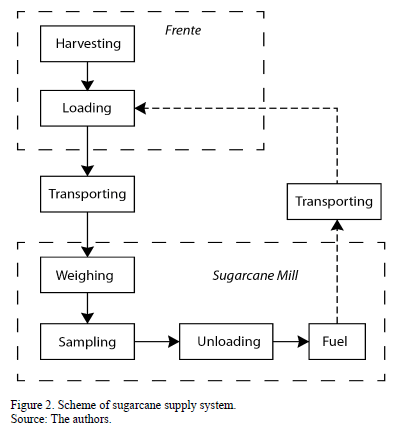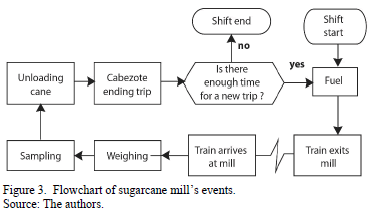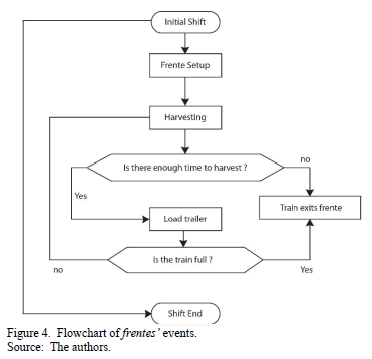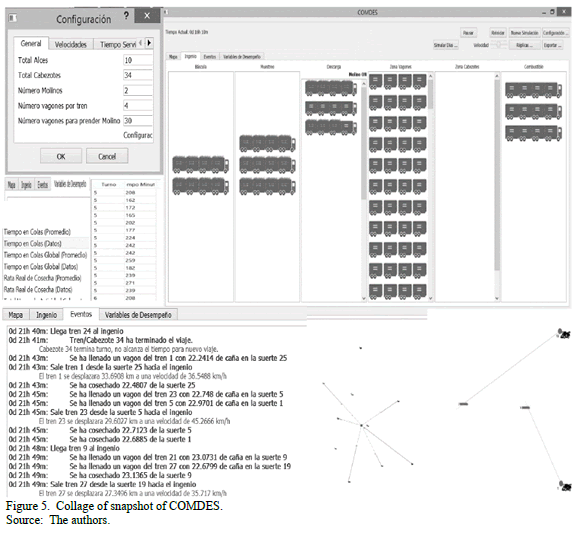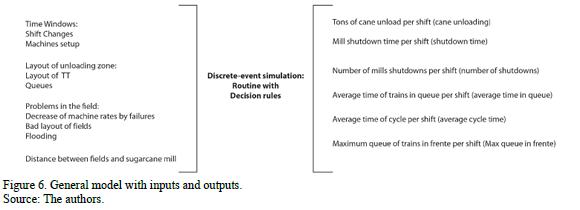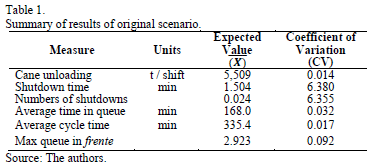Services on Demand
Journal
Article
Indicators
-
 Cited by SciELO
Cited by SciELO -
 Access statistics
Access statistics
Related links
-
 Cited by Google
Cited by Google -
 Similars in
SciELO
Similars in
SciELO -
 Similars in Google
Similars in Google
Share
DYNA
Print version ISSN 0012-7353
Dyna rev.fac.nac.minas vol.83 no.198 Medellín Sept. 2016
https://doi.org/10.15446/dyna.v83n198.52719
DOI: http://dx.doi.org/10.15446/dyna.v83n198.52719
Development of a simulation model as a decision support system for sugarcane supply
Desarrollo de un modelo de simulación como un sistema de soporte de decisiones para el abastecimiento de caña de azúcar
Claudia C. Bocanegra-Herrera a & Carlos Julio Vidal b
a Departamento I.O.P., Universidad Santiago de Cali, Cali, Colombia, claudia.bocanegra00@usc.edu.co
b Escuela de Ingeniería Industrial, Universidad del Valle, Cali, Colombia, carlos.vidal@correounivalle.edu.co
Received: August 25th, 2015. Received in revised form: March 20th, 2016. Accepted: May 30th, 2016.
This work is licensed under a Creative Commons Attribution-NonCommercial-NoDerivatives 4.0 International License.

Abstract
This research presents a discrete-event simulation model of cane supply as a decision support system for managers in a sugarcane mill. The research considers harvesting, transporting, and unloading cane at the mill yard, including the time windows, inherent uncertainty in the system, and queues of all operations. The model was implemented in C++, and the Qt Creator development environment was used to generate a graphical interface. We found that fifty percent of the time, the trailers are waiting; we also assessed the impact of mill downtime on the unloaded cane in the mill yard. Additional environments were also evaluated: rainy period, harvesting in remote places, and an alternative configuration at the unloading area that improves the process efficiency.
Keywords: Discrete-event simulation; sugarcane supply; decision support system.
Resumen
Esta investigación presenta un modelo de simulación de eventos discretos del sistema de abastecimiento de caña como sistema de soporte a las decisiones para los administradores en los ingenios azucareros. Comprende las operaciones de cosecha, transporte y descarga de la caña en el patio del ingenio, además tiene en cuenta ventanas de tiempo, la incertidumbre inherente del sistema y considera las colas de todas las operaciones. El modelo fue implementado en C++ utilizando el entorno de desarrollo Qt Creator para generar una interfaz gráfica. Se encontró que el 50% del tiempo las tractomulas se encuentran en espera, además se evaluó el impacto de los paros de molienda en la cantidad de caña descargada. Otros ambientes fueron también evaluados: época lluviosa, cosecha en campos lejanos y una configuración alternativa en la zona de descarga de caña que mejora la eficiencia del proceso.
Palabras clave: Simulación por eventos discretos; abastecimiento de caña de azúcar; sistema de soporte a las decisiones.
1. Introduction
Sugarcane supply systems at mills are complex due to the high uncertainty in the system and the interrelationships among processes. There is a central administration of a sugarcane mill that coordinates the management and logistics of the supply operations. This coordination is achieved through communication with stakeholders using information systems. Historical average values are used for decision making and compensate for the differences created by the system uncertainty with buffers, whose sizes are based on the experience of decision makers. Uncertainties can cause delays in cane deliveries and transportation overcosts. The primary sources of uncertainty are weather, cane milling rate, design of fields, traffic on roads, and equipment damage.
Power [1] defined a decision support system (DSS) as an interactive computer-based system that helps people use computer communications, data, knowledge, and models to solve problems and make decisions. A DSS based on a discrete event simulation (DES) answers questions concerning what-if scenarios in a statistically valid manner [2] and considers uncertainty, system dynamics, and their interrelationships. Lejars et al. [3] implemented a DSS based on a simulation model that improved the transparency of revenue for both millers and growers. A DSS has been used to improve harvesting and transportation processes [4-8]. The authors in [9] presented a web-based tool that can support decisions for biomass multi-crop production systems on the strategic, tactical, and operational levels.
Specifically for the sugarcane industry, South African and Reunion Island have developed several DESs in Arena, Excel, and a simulation tool called MAGI for decision support of cane supply management [10-15]. For a Mexican sugar plantation, researchers developed a DES to analyze the utilization of machinery and personnel [16]. The researchers in [17] applied a simulation model to reduce the number of mechanical harvesting machines, and the researchers in [18] implemented a simulation model in several sugarcane mills in Australia to decrease harvesting and transportation costs. Jannoni and Morabito [19] developed a DES in Arena focused on the reception area in a Brazilian mill to decrease the time vehicles spent in queues. For the Moroccan sugar industry, the researchers in [20] developed a simulation in SIMUL8; their results showed that the number of transportation units could be reduced by 50% while maintaining the same efficiency. The researchers in [21] developed a simulation model to analyze the impact of the freight and lead time on sugarcane supply profit in a mill. An object-oriented simulation model was built in [22] as an integral part of a DSS to advise farmers with making in-field operational decisions and machinery dimensioning. Other models exist that are different from a simulation such as DSS for sugarcane logistics; these models include algorithms for hierarchical planning of sugarcane harvests [23], a sugar cane operational planning model using mixed-integer programming and adaptive genetic algorithms [24], and a multi-choice goal programming model for sugarcane harvest scheduling, which was proposed in [25].
The structures of sugar mills in these countries are different from those in Colombia in terms of harvest time, capacity, type of equipment, and farm layout. This research describes a DSS based on a DES created with free software called COMDES (Colombian Mill's Discrete Event Simulation) for logistics supply cane of a sugar mill. The system considers time windows, cane download settings, problems at the farm, and the effect of distance, among other factors. To demonstrate the importance of this technique as a decision-making tool for configurations (tactical decisions), policies (strategic decisions), and the effect of uncontrollable variables in the system, in section 2, the logistics of sugarcane mill supply is presented. Next, in section 3, the simulation model is described. Section 4 presents the results and a discussion, and section 5 presents the main conclusions.
2. Supply logistics of sugarcane mills
The sugar cane industry in Colombia is located in the Andean valley of the Cauca River; its climatic conditions allow harvesting throughout the year. Harvesting is performed by an alce (set of operators and machines used to harvest) allocated to a frente (current field being harvested). Harvest can be done manually or mechanically and uses two types of trucks: tractor with a chaser bin in the farm and trailer-truck (TT) for road transportation. The latter uses two train configurations (tractor unit + semitrailer + 3 trailers) and a cabezote (tractor unit). Fig. 1 shows a trailer-truck. Although part of the harvest and transport of sugarcane is done by outsourcing, the sugar mills have a central command of operations, where decisions are made by experts using information systems, such as SIAGRI, and communication with stakeholders using radiotelephones and cellphones. The experts use buffers to deal with randomness.
In this case, the average distance between the cane field and sugarcane mills is 25 km. The harvesting and processing of sugarcane is performed continuously every day for 24 hours.
Fig. 2 illustrates the basic operations of a sugarcane supply system from the transport unit point of view. The process between the frente and the sugarcane mill is as follows: "harvesting" occurs when sugarcane stalks are cut and thrown onto the tractor, and "loading" occurs when the cane in the tractor is loaded onto the train; "transporting" occurs when the train is full or when there is a shift change. The "weighing" operation describes the arrival of every train to the sugarcane mill, and the "sampling" operation describes its inspection. Then, the train goes to the "unloading" area, and the cane is delivered. In the "fuel" operation, the trailer truck fills up with fuel and returns to the field as "empty transporting". The simulation model described in the next section highlights the queues, related random rates, and service times at each stage.
3. Simulation of sugarcane supply system
3.1. Model building and assumptions
The model was built in three steps: conceptual model, implementation of the simulation, and validation.
The model conceptualization defines the scope and level of detail; the main assumption is that the only scarce resources are cabezotes and mechanical harvestings. The rates and service times exhibit a random behavior that can be described by a statistical distribution. Figs. 3 and 4 show the flowchart for events in the sugarcane mill and the frentes that occur within a shift. However, the simulation also takes into account shift changes and equipment setups.
The model was implemented in C++ as an object-oriented model and used the Qt Creator 2.72 development environment to generate the graphical interface. The model was structured into 25 events that represent each of the outcomes necessary to describe the actual system; each event has its own parameters and variables. To quantify the parameters, historical sugar mill data found in literature [26] and data collected through interviews with staff from different mills were used. Most data are given as random distributions to imitate the actual behavior.
The system components are accessed through a menu structure that is easy to use (see Fig. 5), which allows data manipulation, such as the number of tractors in service, number of alces, distributions rates, and working speeds; the simulation output is displayed and can be exported to a spreadsheet format. The simulated system is nonterminating, i.e., it reaches steady state using minutes as the unit of time. For verification and validation, both the conceptual model and the translation to the computer were made from simple to complex.
Throughout the translation process, the proper behavior and its resemblance to the real system were constantly checked using ASSERTs, message lists, visual presentation, and a response variables list. Fig. 6 shows the input values and the performance measures of the simulation.
3.2. Decision rules
Several routines were made inside events, which considered the inherent uncertainty of the system; the following highlights the most important ones:
- Trains to assign to an alce per shift: This routine calculates the minimum number of trains required according to eq. (1)-(5). The allocation of tractor-trailers to an alce is done at the beginning of the shift in the zone of cabezotes that represent the driver change; there are two rules: begin shift, by which trailer-trucks in the zone of cabezotes are allocated to every alce and ending a trip, by which the current alce is no longer required; then, the train can be allocated to another alce.
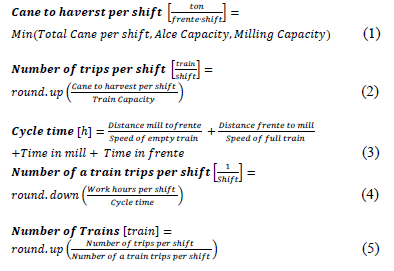
- Working time for transporting: This is used to decide when a train that is unloading cane can make another trip in the same shift:
if current time + cycle time < ending time of shift then
Return to frente
Else
End shift for train
End if
- Time between successive trains: When a shift starts, tractor-trailers are allocated to every alce. Immediately, a train is directed to the field, and then, the other tractor-trailers leave with a departure time described by eq. (6).

- Mill shutdown: When the amount of cane is not enough, the mill is interrupted and restarts when there is a certain amount of sugarcane in the unloading area.
4. Results and discussion
4.1. Current system
The maximum capacity of milling considered was 10,000 t of sugarcane per day with two tandems of mills, 11 alces, and 34 trailer-trucks. In the yard, trains must wait until the cane is unloaded in the mills to continue the route. The simulation warm-up period is the time taken to reach steady state, which was calculated by Welch's method. The system rapidly reaches steady state in 48 hours, and the shift change subsequently forces the transportation and alces to return to the initial state.
The experiments were executed with 12 runs (each run with a different random seed), and each run had 120 batches of 12 h, which results in a total of 1,440 simulation results for every trial and scenario. Table 1 summarizes the results; there is a low variability in the measures except for shutdown time and the number of shutdowns because in a few shifts, the mill breaks down randomly, which is due to the occasional downtime of the mill caused by a random delay in sugarcane delivery.
The maximum amount of cane that can be delivered is approximately 5,520 t per shift. There is a 1:1 ratio between the transport time and the time in queue; in other words, a tractor-trailer spends half its time waiting. It is important to focus on decreasing downtime waiting to improve transport efficiency. Furthermore, because of the need for trailer-trucks drivers to be at the starting place before the shift change, we observed that transportation cannot be fully used at all times.
In this research, we suggest four scenarios to demonstrate the impact of the use of simulation techniques by sugarcane mill managers for analysis and decision making in the supply system.
Scenario 1. Environmental: Rainy period. This scenario considers the random (uncontrollable) factors in operations during rainy periods, recreates the decreased train speed due to wet roads and the decrease in the harvesting rate due to the risk of soil compaction.
4.2. Analysis of scenarios
Scenario 2. Policy: All frentes are located away from the sugarcane mill. In many occasions, due to the need to achieve daily production targets and the lack of strategic and tactical planning, sugarcane mills with mature cane are at distances far away.
Scenario 3. Setting: Change of layout in the unloading area. This situation considers that all trailer-trucks release their cane-filled trailers by unloading cane, and the empty trailers return to the trailers area to continue travel. The loaded trailers will be pulled by a tractor.
Table 2 summarizes the findings. In Scenario 1, it was necessary to adjust a single mill in use, which is a common practice in rainy periods. The amount of unloaded cane decreases by 57%; however, the milling operation is never shut down at any time. The percentage of trains waiting is 65%, which increases the cycle time because of the slower load capacity, which reduces the amount of performed and results in slower milling. Due to the weather, it is important to design new plans for operational decisions to address new frentes, which is a task that is easier done using COMDES by constructing a hierarchical plan.
In Scenario 2, the amount of unloaded cane decreases by 15% due to the increase in the distances of the alce with respect to the sugarcane mill; also, the cycle time increases to 46 minutes, and thus, more tractor trailers are required. In this case, a mill shutdown always occurs per shift, and the expected value of shutdown time increases to 110 minutes. The layout of Scenario 3 has a better performance because it increases the amount of unloaded cane and decreases the time in queues (36% from the queue time). Furthermore, the queue time decreases, the travel time is reduced, and the mill does not stop; therefore, the amount of unloaded cane increases by 0.2% and reaches maximum capacity. An economic and financial evaluation is required to assess if less tractor-units and drivers compensate for the increase in the number of trailers and tractors.
5. Conclusions
When making decisions, one of the primary problems of sugarcane mills in Colombia is not considering the effect of process capability given time windows, uncertainty, and the interactions of system elements. Moreover, due to the large number of variables that change over time and their unclear interactions, it is important to use a DSS, such as COMDES, which uses discrete-event simulations and is adapted to the features of Colombian sugarcane mills. We highlight the fact that the DSS was created using free software and allowed the realization of different types of analyses, both visible and transparent, and improved operational performance of the sugarcane supply chain. COMDES can help make decisions, analyze decisions made by managers, and measure the consequences in a matter of seconds.
Scenario 1 showed the results of difficult environmental conditions by rainy weather (random factors). Scenario 2 presented the effects of a bad policy, in which frentes are located far away from the mill. Scenario 3 showed the impact of a new setting in the yard; however, economic and financial evaluations are required to complete the analysis.
Although the simulation does not use an optimizer, its internal algorithm explores different factors and can help determine near optimal system configurations under the considered performance measures. As future work, it is important to use business software for decision making that can be adapted to the simulation with real time data. This model can be used to study the effect of disturbances, such as transportation breakdowns (terminal simulation) and thus, is recommended for future studies.
Acknowledgements
The authors would like to thank Irene Tischer for her valuable contributions to this work.
References
[1] Power, D.J., Decision support systems: Concepts and resources for managers, Westport: Greenwood publishing Group, 2002. [ Links ]
[2] Cochran, J.K. and Chen, M.S., An integrated multicomputer DSS design for transport planning using embedded computer simulation and database tool, Decision Support Systems, 7, pp. 87-97, 1991. [ Links ]
[3] Lejars, C., Auzoux, S., Siegmund B. and Letourmy P., Implementing sugarcane quality-based payment systems using a decision support system, Computers and Electronics in Agriculture, 70, pp. 225-233, 2010. [ Links ]
[4] Nilsson, D., Dynamic simulation of straw harvesting systems: Influence of climatic, geographical and biological factors on performance and costs, Journal of Agricultural Engineering Research, 76, pp. 27-36, 2000. DOI: 10.1006/jaer.1999.0456 [ Links ]
[5] Sokhansanj, S., Kumar, A. and Turhollow, A.F., Development and implementation of integrated biomass supply analysis and logistics model (IBSAL), Biomass and Bioenergy 30, pp. 838-847, 2006. DOI: 10.1016/j.biombioe.2006.04.004 [ Links ]
[6] Kumar, A. and Sokhansanj, S., Switchgrass (Panicum vigratum, L.) delivery to a biorefinery using integrated biomass supply analysis and logistics (IBSAL) model, Bioresource Technology, 98, pp. 1033-1044, 2007. DOI: 10.1016/j.biortech.2006.04.027 [ Links ]
[7] Parthanadee, P. and Buddhakulsomsiri, J., Simulation modeling and analysis for production scheduling using real-time dispatching rules: A case study in canned fruit industry, Computers and Electronics in Agriculture, 70, pp. 245-255, 2010. DOI: 10.1016/j.compag.2009.11.002 [ Links ]
[8] Mobini, M., Sowlati, T. and Sokhansanj, S., Forest biomass supply logistics for a power plant using the discrete-event simulation approach, Applied Energy, 88, pp. 1241-1250, 2011. DOI: 10.1016/j.apenergy.2010.10.016 [ Links ]
[9] Busato, P. and Berruto, R., A based-web tool for biomass production systems, Biosystem Engineering Special Issue: Operations Management, 120, pp. 102-116, 2013. DOI: 10.1016/j.biosystemseng.2013.09.002 [ Links ]
[10] Barnes, A., Meyer, E. and Schmidt, E., Evaluation of methods to reduce harvest-to-crush delays using a simulation model, Proc. S. Afr. Sug. Technol. Ass., 74, pp. 25-28, 2000. [ Links ]
[11] Guilleman, E., Le Gal, P.Y., Meyer, E. and Schmidt, E., Assessing the potential for improving mill area profitability by modifying cane supply and harvest scheduling: A South African study, Proc. S. Afr. Sug. Technol. Ass., 7, pp. 566-579, 2003. [ Links ]
[12] Le Gal, P.Y., Lejars C. and Auzoux, S., Magi: A simulation tool to address cane supply chain management. Proceedings of the South African Sugar Technologists' Association. Durban, South African, 77, 200, pp. 553-565, 2003. [ Links ]
[13] Lejars, C., Le Gal, P.Y. and Auzoux, S., A decision support approach for cane supply management within a sugar mill area, Computers and Electronics in Agriculture, 60, pp. 239-249, 2008. DOI: 10.1016/j.compag.2007.08.008 [ Links ]
[14] Le Gal, P.Y., Lyne, P.W.L., Meyer E. and Soler, L.G., Impact of sugarcane supply scheduling on mill sugar production: A South African case study, Agricultural Systems, 96, pp. 64-74, 2008. DOI: 10.1016/j.agsy.2007.05.006 [ Links ]
[15] Le Gal, P.Y., Le Masson, J., Bezuidenhout, C.N. and Lagrange, L.F., Coupled modelling of sugarcane supply planning and logistics as a management tool, Computer and Electronics in Agriculture, 68, pp. 168-177, 2009. DOI: 10.1016/j.compag.2009.05.006 [ Links ]
[16] Arjona, E., Perez, V., Bueno, G. and Salazar, L., An interactive simulation environment for evaluating managerial decisions in a sugarcane plantation in Mexico, ARPN Journal of Agricultural and Biological Science, 9, pp. 24-37, 2014. [ Links ]
[17] Higgins, A., Antony, G., Sandell, G., Davies, I., Prestwidge, D. and Andrew, B., A framework for integrating a complex harvesting and transport system for sugar production, Agricultural Systems, 82, pp. 99-115, 2004. DOI: 10.1016/j.agsy.2003.12.004 [ Links ]
[18] Higgins, A. and Davies, I., A simulation model for capacity planning in sugarcane transport, Computers and Electronics in Agriculture, 47, pp. 85-102, 2005. DOI: 10.1016/j.compag.2004.10.006 [ Links ]
[19] Iannoni, A.P. and Morabito, R., A discrete simulation analysis of a logistics supply system, Transportation Research Part E: Logistics and Transportation Review, 42, pp. 191-210, 2006. DOI: 10.1016/j.tre.2004.10.002 [ Links ]
[20] Jorio, R., Legendre, B., Gautz, L. and Abdellaouir, R., Incorporation of sugarcane harvesting and transport variables into a sugarcane harvest and transport scheduling model. Proc. S. Afr. Sug. Technol. Ass., 80, pp. 71-85, 2006. [ Links ]
[21] Rangel, A.J.J., Prado, A.C. and Rangel, L.R., A simulation model to evaluate sugarcane supply systems. Proceedings of the 2010 Winter Simulation Conference, Baltimore, USA, pp. 2114-2125, 2010. DOI: 10.1109/WSC.2010.5678861 [ Links ]
[22] Hameed, I.A., Bochtis, D.D., Sørensen, C.G. and Vougioukas, S., An object-oriented model for simulating agricultural in-field machinery activities, Computer and Electronics in Agriculture, 81, pp. 24-32, 2012. [ Links ]
[23] Tischer, I. y Carrion, A., La planificación jerárquica y su aplicación a la cosecha de la caña de azúcar en Colombia, Ingeniería y Competitividad, 4, pp. 42-52, 2003. [ Links ]
[24] Neungmatcha, W., Sethanan, K., Gen, M. and Theerakulpisut, S., Adaptive genetic algorithm for solving sugarcane loading stations with multi-facility services problem, Computers and Electronics in Agriculture, 98, pp. 85-99, 2013. DOI: 10.1016/j.compag.2013.07.016 [ Links ]
[25] Da Silva, A.F., Silva, F.A. and Dias, E.X., Addressing uncertainty in sugarcane harvest planning through a revise multi-choice goal programming model, Applied mathematical modelling, 39(18), pp. 5540-5558, 2015. DOI: 10.1016/j.apm.2015.01.007 [ Links ]
[26] Amú, L.G., Modelo de simulación y optimización para la gestión logística del sistema de abastecimiento de caña en un ingenio sucro-alcoholero colombiano, Tesis de Grado, Departamento de Ingeniería Industrial, Universidad del Valle, Cali, Colombia, 2011. [ Links ]
C.C. Bocanegra-Herrera, received her BSc. Eng in Chemical Engineering in 2009 with a Sp. in Logistics in 2011 and an MSc. in Engineering in 2014, all of them from the Universidad del Valle, Cali, Colombia. She currently works at the Universidad Santiago de Cali in Cali, Colombia. Her research interests include the following: Discrete-event simulation; supply chain optimization; and lean manufacturing. ORCID: 0000-0002-8593-8879
C.J. Vidal received his BSc. Eng in Mechanical Engineering in 1983 and his MSc. in Industrial and Systems Engineering in 1990, both from the Universidad del Valle, Cali, Colombia. Afterwards, he traveled to the U.S. and received an MSc. and a PhD. in Industrial Engineering in 1998, both from the Georgia Institute of Technology, Atlanta, Georgia, USA. He is currently a professor at the School of Industrial Engineering at the Universidad del Valle. His research interests include the following: Applied optimization and operations research; logistics; supply chain optimization; and inventory systems. ORCID: 0000-0002-4774-9591














